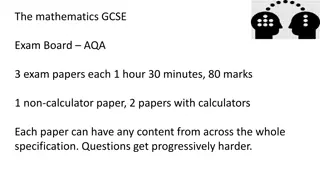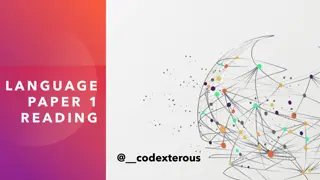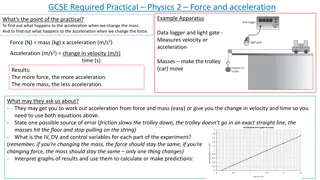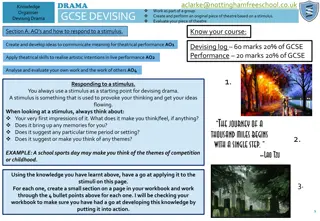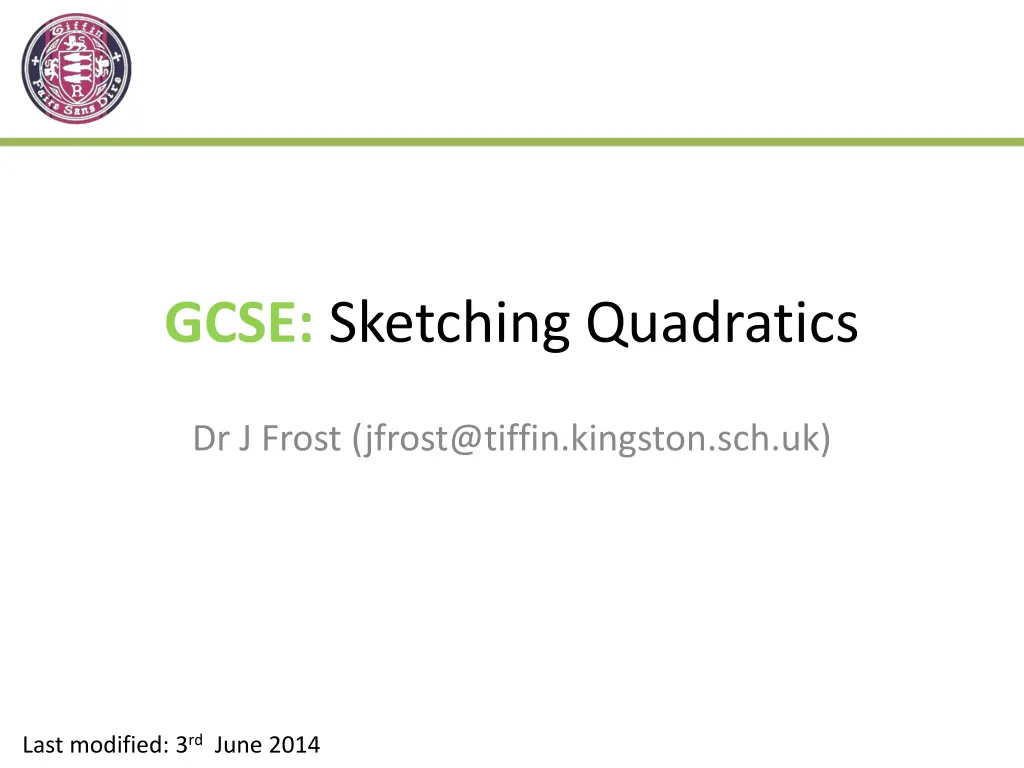
Sketching Quadratics: Understanding Roots and Shapes for Graphing
Explore the concept of roots in quadratics and how they relate to the shape of the graph, with examples and key terms explained. Discover how to sketch quadratic functions with a focus on roots, y-intercepts, and the general shape of the graph.
Download Presentation

Please find below an Image/Link to download the presentation.
The content on the website is provided AS IS for your information and personal use only. It may not be sold, licensed, or shared on other websites without obtaining consent from the author. If you encounter any issues during the download, it is possible that the publisher has removed the file from their server.
You are allowed to download the files provided on this website for personal or commercial use, subject to the condition that they are used lawfully. All files are the property of their respective owners.
The content on the website is provided AS IS for your information and personal use only. It may not be sold, licensed, or shared on other websites without obtaining consent from the author.
E N D
Presentation Transcript
GCSE: Sketching Quadratics Dr J Frost (jfrost@tiffin.kingston.sch.uk) Last modified: 3rd June 2014
Key Terms 1. If y = f(x), then to solvef(x) = 0 means we re trying to find x when y = 0. 2. These are also known as the roots of the function. 3. On the graph, these correspond to where the line crosses the x-axis. ? ? ? y Root Root x ? ? ? The roots of a function ? are the values ? such that ? ? = 0. This corresponds to where its graph crosses the ?-axis.
Would you like $1,000,000? The roots of a function ? are the values ? such that ? ? = 0. The Riemann Zeta Function is a function that allows you to do the infinite sum of powers of reciprocals, e.g. 1 12+1 1 13+1 22+1 23+1 ? 2 = 32+ ? 3 = 33+ One of the 8 Clay Millennium Problems (for which solving any attracts a $1,000,000 prize) is to showing all roots of this function have some particular from, i.e. the form of ? such that ? ? = 0.
Sketching Quadratics y 3 features needed in sketch? Roots ? x General shape: Smiley face or hill? ? y-intercept ?
Example 1 1. Roots 2. y-intercept 3. Shape: smiley face or hill? y ? = ?2 ? 2 = (? + 1)(? 2) ? x -1 2 So if ? = 0, i.e. ? + 1 ? 2 = 0, then ? = 1 or ? = 2. -2 When ? = 0, clearly ? = 2.
Example 2 1. Roots 2. y-intercept 3. Shape: smiley face or hill? y ? = ?2+ 5? 4 = ?2 5? + 4 = ? 1 ? 4 = (? 1)(4 ?) ? ? x 1 4 Bro Tip: We can tidy up by using the minus on the front to swap the order in one of the negations. -4
Example 3 1. Roots 2. y-intercept 3. Shape: smiley face or hill? y 30 ? = ?2+ ? + 30 = ?2 ? 30 = ? + 5 ? 6 = (5 ?)(? 6) ? x ? -5 6
Checking your understanding ? = ?2+ 3? + 2 ? = ?2+ 2? + 8 ? ? ? ? ? ? ? = 2,4 Roots? x = -1, -2 Roots? ? = 8 y-Intercept? or shape? y = 2 y-Intercept? or shape? y y 8 2 ? ? x x -2 -1 -2 4
Checking your understanding ? = 9 ?2 ? = 2?2 5? 3 ? ? ? ? = 0.5,3 ? ? ? Roots? x = -3, 3 Roots? ? = 3 y-Intercept? or shape? y = 9 y-Intercept? or shape? y y 9 ? ? x x -0.5 -3 3 3 -3
Exercises Sketch the following, ensuring you indicate where the curve intercepts either of the axes. ? = ?2+ ? 2 ? = 5 ?2 1 5 ? = 10 + 3? ?2 ? = ?2 10? + 24 6 2 7 ? = 9? 4 2?2 ? = ?2 4? 5 3 ? = ?2 2 4
Determining Min/Max Points Try to sketch ? = ?2 6? + 10. What problem do you encounter? There are no roots (i.e. solutions to ?? ?? + ?? = ?). Thus it s hard to know how to sketch it where does the dip occur? ? ? ? ? ? 10 10 ? ? Completing the square allows us to find where the minimum or maximum point on the graph is
Suppose we complete the square... ? = ?2 6? + 10 = ? 32+ 1 ? How could we use this completed square to find the minimum point of the graph? (Hint: how do you make ? as small as possible in this equation?) ? Anything squared must be at least 0. So to make the RHS as small as possible, we want ? 32 to be 0. This happens when ? = 3. When ? = 3, ? = 1. ?
Write down When we have a quadratic in the form: ? = ? + ?2+ ? The minimum point is ?,? .
Complete the table, and hence sketch the graphs Equation Completed Square x at graph min y at graph min y-intercept Roots? y = x2 + 2x + 5 y = (x + 1)2 + 4 1 -1 4 5 None y = x2 4x + 7 y = (x 2)2 + 3 2 2 3 7 None ? ? ? ? ? ? ? ? y = (x + 3)2 36 ? x = 3 or -9 ? y = x2 + 6x 27 3 -3 -36 -27 1 2 3 7 3 -9 5 ? ? (2,3) (-1,4) -27 (-3,-36)
Answers to Min/Max Point Card Sort ? ? ? ? ? ?
? ? ? ? ??? ?????:( 1, 4) ? ?
Quadratic With Maximum Points If the coefficient of ?2 is negative, we will have a maximum point. ? = ?2+ 8? 5 = ?2 8? + 5 = ? 42 11 = ? 42+ 11 Completed Square ? = 11 ? 42 4,11 Identifying the maximum point is a similar principle. To maximise ?, we want to subtract a small a value as possible. ? 42 is smallest when ? = 4 to make it 0. 4 + 11 4 11 -5 Graph ?
Test Your Understanding Sketch the following, indicating the maximum point and ?-intercept. ? = ?2 10? + 3 = ?2+ 10? 3 = ? + 52 28 = 28 ? + 52 ? = 3?2+ 12? 6 = 3 ?2 4? + 2 = 3 ? 22 2 = 6 3 ? 22 Completed Square ? Completed Square ? 2,6 5,28 3 -6 Graph ? Graph ?
Exercises Sketch the following, including the minimum and maximum point (and any intercepts with the axes). ? = ?2+ 8? + 20 = ? + 42+ 4 ? = 5?2 10? + 10 = 5 ?2 2? + 2 = 5 ? 12+ 1 = 5 ? 12+ 5 1 3 ? 20 ? 10 (-4,4) 1,5 ? = ?2+ 4? 3 = ?2 4? + 3 = ? 22 1 = 1 ? 22 2 ? = 16? 4?2 8 = 4?2+ 16? 8 = 4 ?2 4? + 2 = 4 ? 22 2 = 8 4 ? 22 4 ? 2,8 ? 2,1 -8 -3
For each question... 1. Solve It 2. Swap book 3. Show card Answer the question given, making sure you show working. Swap books with your neighbour. They will mark the question according to the provided mark scheme. Your neighbour will show: Red if all wrong. Yellow if partial marks. Green if fully correct.
Q1 Put 3x2 + 24x + 6 in the form a(x + p)2 + q. Hence sketch y = 3x2 + 24x + 6 3(x+4)2 - 42 (2 marks) ? 1 mark: Roots (both on left-side of y-axis) 1 mark: y-intercept of +6 1 mark: Min point 1 mark: Correct shape (smiley face) ? +6 -4- 14 -4+ 14 (-4,-42)
Q2 Put 4x2 6x + 2 in the form a(x + p)2 + q. Hence sketch y = 4x2 6x + 2 4(x )2 ? (2 marks) 1 mark: Roots 1 mark: y-intercept 1 mark: Min point 1 mark: Correct shape (hill face) +2 ? 0.5 1 ( , - )
Q3 Put -5x2 + 10x 6 in the form a(x + p)2 + q. Hence sketch y = -5x2 + 10x 6 -5(x 1)2 - 1 (2 marks) ? (1, -1) 1 mark: y-intercept 1 mark: Max point 1 mark: Correct shape (hill) ? -6
GCSE: Sketching Quadratics Solving Quadratics By Sketching Graphs Dr J Frost (jfrost@tiffin.kingston.sch.uk)
RECAP: Solving Quadratics by using a Graph Edexcel Nov 2011 NonCalc a) Use the graph to find estimates for the solutions of i. ?2 5? 3 = 0 Accept ?.? to ?.?, ?.? to ?.?. ii. ?2 5? 3 = 6 ? = ?.?,?.? Recall that we can find the solutions to two simultaneous equations by drawing the two lines, and finding the points of intersection. ? ? b) Use the graph to find estimates for the solutions of the simultaneous equations: ? = ?2 5? 3 ? = ? 4 ? = ?.?,? = ?.? ? = ?.?,? = ?.? Since ? = ?2 5? 3 and we want 0 = ?2 5? 3, we re looking where ? = 0. ? Bro Tip: Remember that the easiest way to sketch lines like ? = ? 4 is to just pick two sensible values of ? (e.g. 0 and 4), and see what ? is for each. Then join up the two points with a line.
Test Your Understanding (see supplied sheet) The graph shows ? = 9?2+ 36? + 32. Estimate the solutions to 9?2+ 36? + 32 = 0 Determine the solutions to 9?2+ 36? + 32 = 5 By using your graph, solve the simultaneous equations: ? ? ? = ?.?, ?.? ? = ?, ? a b c ? = 9?2+ 36? + 32 ? = ? + 5 ? = ?.?,? = ?.? ? = ?.?,? = ?.? ?
Question 1 The above is the graph ? = ?2 10? + 5. Estimate the solutions of ?2 10? + 5 = 0? = ?.? ?? ? = ?.? Estimate the solutions of ?2 10? + 5 = 10? = ?.? ?? ? = ?.? By drawing an appropriate graph, estimate the solutions to the simultaneous equations: ? = ?2 10? + 5 ? = 2? 5 ? ? a b c ? = ?.?,? = ?.? ? = ??.?,? = ??.? ?
Question 2 What are the roots of ? ? ? ? = ?,? ? By drawing a suitable line, estimate the solutions to ?2+ 2? 3 = 4 ? ? = ?.?,?.? ?
Question 3 Use the grid provided to draw the graph of ? = 5 ?2 (Hint: use an appropriate table of values to work out the points first) Use your graph to find an estimate of the solution to 5 ?2= 3 ? = ?.?,?.? By sketching a suitable line, solve the simultaneous equations: ? = 5 ?2 ? = 2? 2 ? = ?.?,? = ?.? ? = ?.?,? = ?.? ? ?
Question 4 The sketch below is of ? = 6 ?2 2?. By sketching a suitable graph, approximate the solutions to ?2 ? + 3 = 0 (Hint: Manipulate this to put 6 ?2 2? on one side of the equation and see what s on the other side of the equation). ?? ? + ? = ? ? ?? ?? = ? ? ? = ?.?,?.? ?
Question 5 Above is a sketch of the cubic ? = ?3 ?. By sketching an appropriate line, estimate solutions to the equation ?3 2? + 1 = 0. ?? ?? + ? = ? ?? ? = ? ? ? So sketch ? = ? ?. Solutions: ? = ?, ?.??, ?.??





